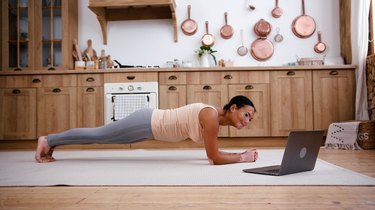
Planks are among the best exercises for strengthening your core. But while planks can work wonders for your midsection, for some, because of the immense pressure placed on your two relatively small elbow joints from your body weight, they can result in sore elbows.
Think about it: Instead of balancing on your hands and feet, a lot of your weight is going straight from your shoulders to your elbows, pressing them into the floor. And especially if you're not distributing some of your weight into your forearms, this puts a lot of pressure on your elbows.
Video of the Day
Video of the Day
Fortunately, there are things you can do to ease this discomfort. Here are seven potential tips for sore elbows when planking from fitness experts.
1. Add Some Padding
Your elbows are generally pretty bony without much natural padding surrounding the joint. That's why it can help to add some external cushioning between your elbows and the floor, says Grace Albin, Pilates and fitness instructor in Miami-Fort Lauderdale. "This is as simple as doubling up your mat, using a towel or a small blanket."
2. Tweak Your Plank
Another option is to change how you do your plank — even just slightly — to help redistribute the pressure your elbows are taking. Try planking from the top position of a push-up, says Ignis Labuschagne, fitness instructor at Miha Bodytec, EMS studio in Pretoria, South Africa.
If you're up for even more of a challenge, perform your plank in the bottom position of a push-up. Doing your plank in the end position, explains Labuschagne, is tough on the deltoids (shoulder) and pectorals (chest).
"Doing it this way, you'll reach failure in a quicker manner but without the limitation of getting sore elbows."
3. Adjust Your Body Weight
Rather than putting all that pressure straight into your elbows, try adjusting your body weight by spreading your fingers out so that your whole palm is on the floor, Albin says.
"This works better than making a fist because it allows your hands to absorb some weight which can lift off your elbows," Albin says. "Slowly and consciously shift your body weight forward so that it gets more evenly distributed to your hands rather than all being in your elbows," she says.
"Now do the same thing in reverse: Slowly and consciously shift your body weight backward so that more of it is held in your lower body (hips, legs, feet) rather than falling through your elbows."
4. Use a Pilates Ball
Use a Pilates ball to help alleviate the pressure by placing the ball under your forearms — just make sure your glutes and thighs are tightened as you make use of the ball — says Liza McAllister, fitness instructor and owner of Levelled with Liza.
"Remember your plank must be straight, no matter what angle you are at," she says. "And make sure that your arms are always aligned — shoulders over elbows."
5. Do a Straight-Arm Plank With Dumbbells
If your elbows are still taking strain after making modifications, try doing a straight-arm plank using dumbbells, Albin says.
"Place dumbbells on the floor and hold the dumbbells with your hands — which is more natural on the wrists and more comfortable than doing a straight-arm plank with your hands straight on the floor," she says.
"Another progression is having your arms straight, but one or both knees on the floor. Lift the knees for a few seconds at a time into a full plank, then gently relax them back down. Do it again and hold at the top for a few seconds longer. Keep going and building on your progress."
6. Reverse Your Plank
If you're getting no joy from changing your form or using padding as buffers for your elbows, reversing your plank may help you get the benefits of a plank but without compromising your elbows.
Mimic the movement lying on your back and hold weights directly above your chest to engage the upper body and raise your legs off the floor to engage your core, McAllister says. Just make sure your lower back stays on the ground.
7. Use a BOSU Ball or Bench
One last option is to use a BOSU ball to support your elbows. "You can use the rounded side of the BOSU and lean your elbows on that," McAllister says. Alternatively, you can support your upper body on a bench.
"You could completely take the weight off of your elbows by supporting your torso on a bench, arms under your torso and using your forearms (tucked so the pressure is off your elbows) for support as you do the plank," McAllister says.